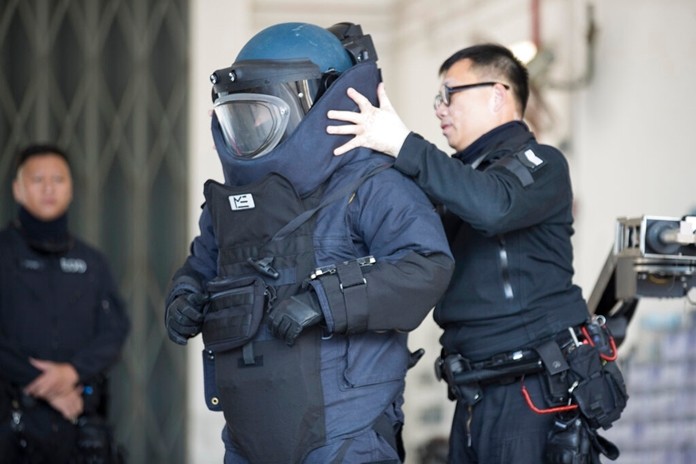
HONG KONG (AP) — Hong Kong’s much-maligned police force provided a rare behind-the-scenes look Friday at its bomb disposal squad to show the potentially deadly destructive force of homemade explosives seized during months of protests that have shaken the semi-autonomous Chinese territory.
In a demonstration for media cameras, the bomb squad set off a series of controlled explosions in a disused quarry overlooking the city’s high-rise skyline, blowing up a watermelon and shredding the front of a minivan.
In July, police announced the seizure of about 2 kilograms (4.4 pounds) of TATP, which has been used in militant attacks worldwide. Other recent seizures in Hong Kong involved far smaller amounts, just 1 gram, of TATP, or tri-acetone tri-peroxide.
“Obviously, I’m concerned that they are making TATP or are in possession of TATP,” said Alick McWhirter, the squad’s senior bomb disposal officer.
Just 1 gram of the unstable explosive, equivalent to the weight of a candy, could cause serious injuries, he said.
A demonstration blast of 1 gram of high explosive at the quarry above the bomb squad’s fenced-off headquarters caused a loud bang. A blast involving 50 grams, which would fit into a cigarette packet, sent shrapnel flying from the shattered front of the minivan.
The squad used explosives with a destructive force equivalent to TATP but not TATP itself, because the substance is dangerous to handle and is susceptible to bumps, heat and friction.
“Because I like having 10 fingers, I am not going to use TATP,” McWhirter said.
In October, police said a homemade remote-controlled bomb intended to “kill or to harm” riot control officers was detonated as they deployed against protests. Causing a loud thud but no injuries, the small blast was the first known use of an explosive device during the protests that started in June over a contested extradition bill and snowballed into an anti-government, anti-police and anti-China movement.
The bomb squad has also disposed of thousands of gasoline bombs prepared by protesters on university campuses.
McWhirter said that “99% of the protesters in Hong Kong, from what I’ve seen, are peaceful.”
But he added: “There’s clearly, though, a small hard core who are dedicated towards violence.”
“The ones creating these explosives are a tiny percentage of a tiny percentage,” he said. “Petrol bombs, TATP, are not the normal in Hong Kong.”
Distrust goes both ways. Protesters accuse police of systematic abuses. The widespread use of police tear gas and thousands of often muscular arrests have infuriated many in Hong Kong. A call for an independent investigation of police conduct is among protesters’ key demands.
A rally demanding a stop to tear gassing attracted about 500 people Friday night in central Hong Kong.
Organizers of the protest expressed fears of possible health risks from the noxious choking clouds of gas liberally deployed to disperse demonstrators and displayed photos of people with nasty rashes and other ailments they said were caused by Hong Kong becoming “a city-wide gas chamber.”
McWhirter, an officer in Hong Kong for 30 years, expressed dismay that relations have soured so dramatically between the police force, long regarded as Asia’s finest, and citizens it claims to serve and protect.
“I watched the officers day after day, night after night, month after month, going out and holding the line,” he said. “They are being attacked with knives, with explosives and petrol bombs, and they hold the line and use remarkable self-control in the face of incredible violence.”




